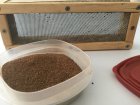Dear Fellow Turning Junkies - let me know if you want to borrow my needle.
I found the lower viscosity Aero-Marine #300 will easily go through a #22 and, with some pressure, a #25 needle. These can be easily had at you local pharmacy - you'll get those "knowing smiles" when you tell them your shooting epoxy into your turnings.
To my thinking, a patched worm hole or crack, when filled with a almost matching filler, screams, "defect". Use a super dark brown or even black and it becomes interesting.

I found the lower viscosity Aero-Marine #300 will easily go through a #22 and, with some pressure, a #25 needle. These can be easily had at you local pharmacy - you'll get those "knowing smiles" when you tell them your shooting epoxy into your turnings.
To my thinking, a patched worm hole or crack, when filled with a almost matching filler, screams, "defect". Use a super dark brown or even black and it becomes interesting.


